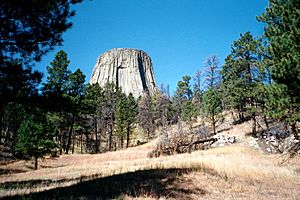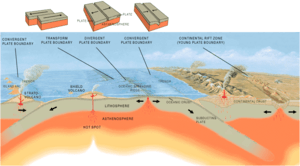Volcanism facts for kids
Volcanism is when hot, melted rock from deep inside Earth bursts out onto the surface. This melted rock is called magma. When it reaches the surface, it's called lava.
Deep under the Earth's crust, magma is under huge pressure. Sometimes, the Earth's crust cracks or breaks. These cracks are like weak spots.
When these weak spots go deep enough to reach the magma, they let the pressure out. This allows the magma to push up through the cracks. Some magma stays underground, but some can reach the Earth's surface as lava.
Contents
Volcanoes
Volcanoes are special places where magma comes out of the Earth. The way a volcano looks depends on where the eruption happens. It also depends on how thick or runny the magma is.
Magma Underground: Intrusions

Sometimes, magma pushes into the rocks under the Earth's crust. This is called intrusive volcanism. When this magma cools down and becomes solid while still underground, it forms different shapes. These shapes are called plutons. The rock formed is a type of igneous rock.
Over a very long time, the rocks above these plutons can wear away. This process is called denudation. When the top layers are gone, the plutons become visible on the surface.
Here are some main shapes formed by magma cooling underground:
- Batholiths: These are very large areas of magma that cooled deep down, often at the bottom of mountains.
- Dykes: These are smaller amounts of magma that cooled vertically. They cut across the existing rocks like a wall.
- Sills: These are also smaller amounts of magma, but they cooled horizontally. They lie flat between layers of existing rocks.
- Laccoliths: This is when magma pushes up the layers of rock above it. It creates a dome-shaped structure underground.
Magma on the Surface: Extrusions
When melted magma pushes its way through cracks and reaches the Earth's surface, it's called "igneous extrusion." The materials that come out can be gas, liquid, or solid.
- Gas: Volcanoes release gases like sulfur, hydrogen, carbon dioxide, and hot steam. Sometimes, these gases can shoot out as geysers. If the pressure drops quickly, gases inside the magma can explode.
- Solid: These are called pyroclasts. They are pieces of rock, hardened lava, and fine materials like volcanic ash and dust. They come in different sizes, from large volcanic bombs to tiny dust particles.
- Liquid: The most common liquid is lava. There are also hot springs, which are natural springs of hot water.
Here are some features formed by magma reaching the surface:
- Caldera: This is a large, bowl-shaped hole left after a volcano erupts and collapses. If it fills with water, it becomes a 'caldera lake'.
- Composite cones: These are large volcanic mountains. They are built up over time by layers of hardened lava and ash.
- Geysers: These are natural hot springs that shoot hot water and steam high into the air. They erupt at regular times.
- Hot springs: These are places where hot water flows out of the ground all the time. Unlike geysers, they don't shoot water into the air.
Images for kids
-
Plate tectonics map with volcano locations shown by red circles
-
Runny lava flowing from Kīlauea volcano
See also
 In Spanish: Vulcanismo para niños
In Spanish: Vulcanismo para niños




